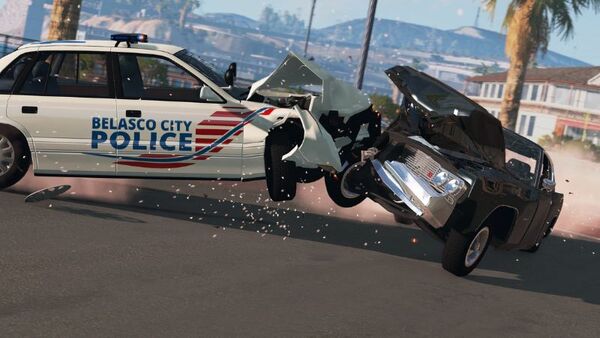Advertisement
Popular Now
BeamNG.drive, a soft-body vehicle simulation game, has gained widespread recognition for its highly detailed physics engine that allows for realistic vehicle behavior and damage modeling. While the game’s sandbox nature offers players the freedom to explore a variety of driving scenarios, the core of its appeal lies in its groundbreaking physics system. This article will explore the deep intricacies of BeamNG.drive's physics engine, focusing on how it affects gameplay, realism, and the modding community, making it a unique experience in the world of driving simulators.
We will delve into the mechanics behind the game's physics engine, analyze its effects on gameplay, and consider the implications it has for both casual players and modders.
 The key selling point of BeamNG.drive is its advanced soft-body physics engine[/caption]
The physics engine simulates forces such as friction, gravity, and air resistance in great detail, making it possible to recreate everything from simple driving scenarios to full-blown crashes with precise accuracy. The depth of the physics system allows players to experience the most realistic driving experience, but it also comes with challenges that affect the game’s playability and accessibility.
The key selling point of BeamNG.drive is its advanced soft-body physics engine[/caption]
The physics engine simulates forces such as friction, gravity, and air resistance in great detail, making it possible to recreate everything from simple driving scenarios to full-blown crashes with precise accuracy. The depth of the physics system allows players to experience the most realistic driving experience, but it also comes with challenges that affect the game’s playability and accessibility.
 These modifications are a testament to the game's active community[/caption]
These modifications are a testament to the game's active community[/caption]
 The developers continually release updates[/caption]
The developers continually release updates[/caption]
Introduction to BeamNG.drive’s Physics Engine
The key selling point of BeamNG.drive is its advanced soft-body physics engine, which provides unparalleled realism in vehicle simulation. This engine simulates every component of a vehicle, allowing players to experience lifelike car behavior and damage. [caption id="attachment_1668" align="aligncenter" width="600"] The key selling point of BeamNG.drive is its advanced soft-body physics engine[/caption]
The physics engine simulates forces such as friction, gravity, and air resistance in great detail, making it possible to recreate everything from simple driving scenarios to full-blown crashes with precise accuracy. The depth of the physics system allows players to experience the most realistic driving experience, but it also comes with challenges that affect the game’s playability and accessibility.
The key selling point of BeamNG.drive is its advanced soft-body physics engine[/caption]
The physics engine simulates forces such as friction, gravity, and air resistance in great detail, making it possible to recreate everything from simple driving scenarios to full-blown crashes with precise accuracy. The depth of the physics system allows players to experience the most realistic driving experience, but it also comes with challenges that affect the game’s playability and accessibility.
The Core of BeamNG.drive’s Realism
Soft-Body Dynamics
At the heart of BeamNG.drive's realism is the soft-body physics model, which differentiates it from other driving simulators. Unlike rigid-body physics, which approximates vehicle structure with fixed points, soft-body physics simulates individual components. Each part of the vehicle-whether it's the chassis, wheels, or suspension-interacts independently with external forces. This system enables players to witness the fine-tuned impact of crashes on their vehicles, where each deformation and mechanical failure occurs based on the exact location and force of impact. This leads to highly realistic damage modeling, which can be both visually satisfying and strategically significant in gameplay.Influence on Driving Mechanics
The advanced physics system doesn't only affect crashes; it also greatly influences driving dynamics. The way a vehicle accelerates, brakes, and handles corners all depend on a multitude of factors, such as weight distribution, suspension stiffness, and tire friction. For players used to arcade-style driving games, this level of precision can be challenging, but for enthusiasts, it provides a rewarding learning curve.Driving Complexity
Weight Distribution: The distribution of weight across a vehicle directly affects how it handles turns and maneuvers. For example, cars with more weight at the rear are prone to oversteering, while those with heavier fronts tend to understeer. Suspension Dynamics: Suspension tuning in BeamNG.drive is crucial for managing uneven terrain and high-speed maneuvers. Poorly configured suspension can result in loss of control, especially when navigating challenging environments. Tire Friction: Tire behavior in the game is influenced by various factors, including surface type, temperature, and wear. Players must adapt their driving to account for the loss of traction in wet or rough conditions.Challenges and Accessibility in BeamNG.drive
Steep Learning Curve
One of the issues many new players face in BeamNG.drive is the steep learning curve presented by the realistic physics. The game lacks a traditional campaign mode or structured tutorials, which leaves players to experiment with different scenarios to learn the mechanics. For beginners, this can be overwhelming as the game’s physics engine requires a deeper understanding of vehicle dynamics than most other driving games.Learning Through Trial and Error
While this unstructured approach to gameplay allows for creativity and experimentation, it can be frustrating for those looking for a more guided experience. Players often find themselves struggling to control vehicles properly in the early stages, as even the smallest mistakes can result in significant consequences, such as a total vehicle breakdown.Accessibility Modifications
Given the complexity of the physics engine, the modding community has developed several tools and modifications aimed at easing the player experience. These include: Driving Aids: Mods that introduce stability control, traction control, and other driving aids help reduce the challenge for less experienced players. Simplified Vehicle Models: Some mods offer simplified vehicle behavior, reducing the complexity of crashes and making vehicles more forgiving to drive. These modifications are a testament to the game's active community, which works to bridge the gap between realism and accessibility for new players. [caption id="attachment_1670" align="aligncenter" width="600"] These modifications are a testament to the game's active community[/caption]
These modifications are a testament to the game's active community[/caption]
The Role of Modding in Expanding BeamNG.drive
Vehicle and Map Creation
BeamNG.drive’s active modding community plays a critical role in the game’s longevity and depth. The game allows users to create and share custom vehicles and maps, significantly expanding the content available to players. The physics engine supports these creations, making the possibilities for new driving experiences almost limitless.Custom Vehicles
The community has introduced everything from realistic car replicas to fantastical vehicles like tanks and monster trucks. The ability to fine-tune vehicle parameters such as weight, suspension, and aerodynamics allows for a wide variety of driving experiences, ranging from realistic to highly experimental.Custom Maps
Custom maps offer different driving terrains that further challenge the physics engine. From vast open-world environments to tightly designed race tracks, modders push the limits of the game’s physics system by creating scenarios that test players' driving skills in new ways.Expanding the Realism
Modders also contribute to enhancing the realism of the game through custom scripts and modifications that introduce more advanced vehicle behaviors, weather conditions, and damage models. For example, some mods introduce more complex suspension systems or realistic tire wear, adding to the already intricate physics engine.Technical Challenges of the Physics Engine
Performance Demands
One of the biggest technical challenges of BeamNG.drive's physics engine is its impact on system performance. Simulating each vehicle component in real-time requires significant processing power. As a result, players with lower-end PCs may struggle to run the game smoothly, especially when dealing with multiple vehicles or complex environments.Managing Resources
To alleviate some of these performance issues, BeamNG.drive offers graphical and physics settings that allow players to adjust the level of detail in the simulation. Reducing the complexity of vehicle damage modeling or lowering the number of active vehicles can help maintain performance without sacrificing too much realism.Optimizations by Developers
The developers continually release updates that optimize the physics engine, improving its efficiency and reducing the strain on hardware. These updates help ensure that even players with mid-range systems can enjoy the core experience without too many sacrifices in terms of realism. [caption id="attachment_1671" align="aligncenter" width="600"] The developers continually release updates[/caption]
The developers continually release updates[/caption]

















